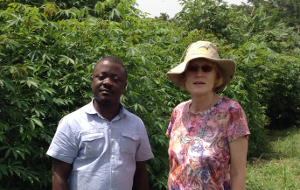UFS PhD student receives more than R5,8 million to take agricultural research to African farmers
 Prof Maryke Labuschagne and Bright Peprah. (Photo: Supplied) Prof Maryke Labuschagne and Bright Peprah. (Photo: Supplied) |
Bright Peprah, a Plant Breeding PhD student from Ghana in the Department of Plant Sciences at the University of the Free State received an award from the competitive Program for Emerging Agricultural Research Leaders (PEARL) of the Bill and Melinda Gates Foundation (BMGF) for one of his projects.
From the more than 750 proposals for funding that were received from African researchers, only 19 received funding from PEARL. PEARL is an agricultural initiative by the BMGF to take agricultural research products to African farmers. It also aims at involving the youth and women in agriculture.
Peprah’s proposal to introgress beta carotene into farmer-preferred cassava landraces was part of the final 19 proposals funded. The project is being led by the Council for Scientific and Industrial Research (CSIR)Crops Research Institute (CRI), and has the International Institute of Tropical Agriculture (IITA) and the International Centre for Tropical Agriculture (CIAT) as international partners with Peprah as the principal investigator.

The development of nutrient-dense cassava cultivars needs attention to eliminate the ramifications of malnutrition among the poor in an inexpensive and more sustainable way.
Photo: Supplied |
He received $473 000 (R5,8 million) for his project on the improvement of beta-carotene content in cassava.
Peprah decided on this project because the populations of underdeveloped and developing countries, such as Ghana, commonly suffer undernourishment and/or hidden hunger, predisposing them to diseases from micronutrients deficiencies. “Vitamin A deficiency constitutes an endemic public health problem which affects women and children largely,” he says.
“In Africa, cassava is widely consumed by the populace. Unfortunately, in these areas, malnutrition is endemic to a significant extent, partly due to the low micronutrients in this tuberous root crop, which is a major component of most household diets. It is for this reason that the development of nutrient- dense cassava cultivars needs much attention to eliminate the ramifications of malnutrition among the poor in an inexpensive and more sustainable way.
“To date we have selected top eight genotypes from germplasm collected from the International Institute of Tropical Agriculture (IITA) which are high in carotenoids and also poundable, a key trait to Ghanaian farmers. These eight genotypes have been planted at different locations in Ghana, and being evaluated by different stakeholders (consumers, researchers, producers, commercial farmers, processors, etc.). If found suitable, the genotypes will be released to farmers, which we hope will solve some of the micronutrient problems in Ghana.
“My projects seek to develop new cassava varieties that will have both high dry matter and beta carotene which has been reported to be negatively correlated (as one increase, the other decreases). The breeding method will be crossing varieties that are high in beta carotene with those with high dry matter, and checking the performance of the seedlings later. Developing such new varieties (yellow flesh cassava) will increase their adoption rate by Ghanaian farmers,” he said.
Prof Maryke Labuschagne, Professor in Plant Breeding in the Department Plant Sciences and Peprah’s study leader, said: “This project has the potential to alleviate vitamin A deficiency in the West African region, where this deficiency is rampant, causing blindness in many people, especially children."